The ASUS ROG Strix Z370-F Gaming Review: A $200 Motherboard at 5.1 GHz
by Joe Shields on October 1, 2018 8:00 AM EST- Posted in
- Motherboards
- Asus
- ROG
- M.2
- USB 3.1
- Strix
- Coffee Lake
- i7-8700K
- Z370-F Gaming
- SupremeFX
CPU Performance, Short Form
For our motherboard reviews, we use our short form testing method. These tests usually focus on if a motherboard is using MultiCore Turbo (the feature used to have maximum turbo on at all times, giving a frequency advantage), or if there are slight gains to be had from tweaking the firmware. We leave the BIOS settings at default and memory at JEDEC for the supported frequency of the processor for these tests, making it very easy to see which motherboards have MCT enabled by default.
Rendering - Blender 2.78: link
For a render that has been around for what seems like ages, Blender is still a highly popular tool. We managed to wrap up a standard workload into the February 5 nightly build of Blender and measure the time it takes to render the first frame of the scene. Being one of the bigger open source tools out there, it means both AMD and Intel work actively to help improve the codebase, for better or for worse on their own/each other's microarchitecture.
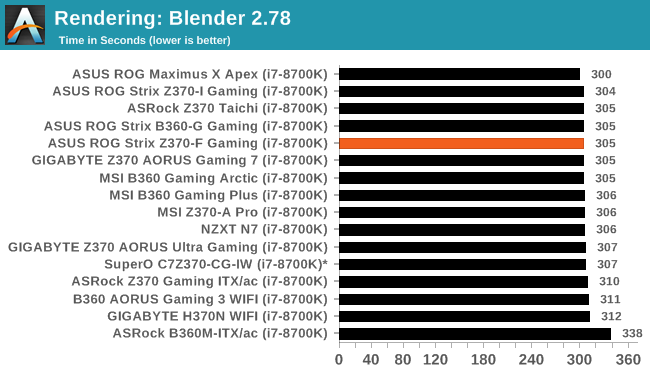
In the Blender results, the ASUS Z370-F completed the test in 305 seconds which matches up with the majority of the other results. Out of the box the board did not hit any throttling as we have seen in other, lesser boards, mostly of the B360 variety.
Rendering – POV-Ray 3.7: link
The Persistence of Vision Ray Tracer, or POV-Ray, is a freeware package for as the name suggests, ray tracing. It is a pure renderer, rather than modeling software, but the latest beta version contains a handy benchmark for stressing all processing threads on a platform. We have been using this test in motherboard reviews to test memory stability at various CPU speeds to good effect – if it passes the test, the IMC in the CPU is stable for a given CPU speed. As a CPU test, it runs for approximately 1-2 minutes on high-end platforms.
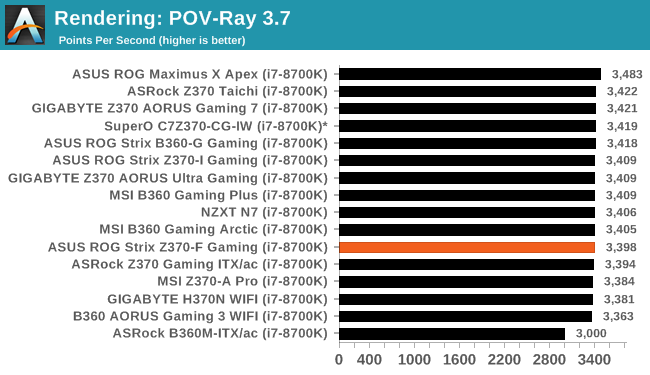
In our next rendering test, POV-Ray, the Z370-F scores 3398 points per second which land the result in the middle of the pack. Here again, clocks were maintained without throttling.
Compression – WinRAR 5.4: link
Our WinRAR test from 2013 is updated to the latest version of WinRAR at the start of 2014. We compress a set of 2867 files across 320 folders totaling 1.52 GB in size – 95% of these files are small typical website files, and the rest (90% of the size) are small 30-second 720p videos.
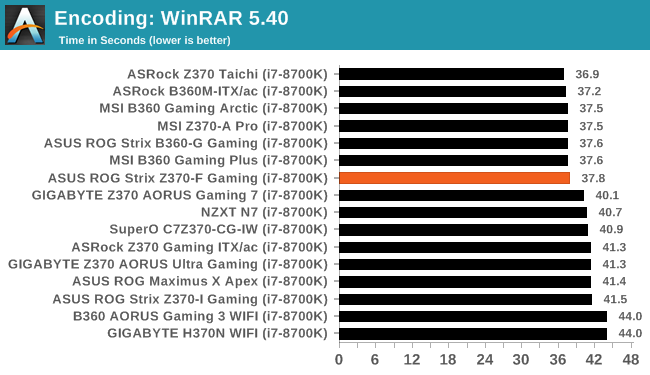
In our compression tests, the Z370-F Gaming managed a middling result overall with a time of 37.8 seconds. This is the slowest time so far using the updated OS, but less than 3% separates it from the top.
Synthetic – 7-Zip 9.2: link
As an open source compression tool, 7-Zip is a popular tool for making sets of files easier to handle and transfer. The software offers up its own benchmark, to which we report the result.

Moving on to 7-Zip, the board scored 38,201 which places it towards the bottom of our results. Clock speeds and such were the same with all boards, with a relatively small variance between boards that used the same boost clocks.
Point Calculations – 3D Movement Algorithm Test: link
3DPM is a self-penned benchmark, taking basic 3D movement algorithms used in Brownian Motion simulations and testing them for speed. High floating point performance, MHz, and IPC win in the single thread version, whereas the multithread version has to handle the threads and loves more cores. For a brief explanation of the platform agnostic coding behind this benchmark, see my forum post here.
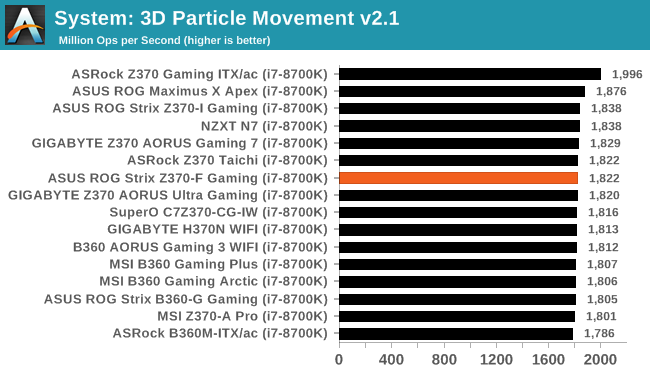
In 3DPM21, The Z370- Gaming reached 1822 Mop/s, placing it in the middle of other results. The scores of almost all Z370 and i7-8700K testing were within 60 points (around 3%) of each other. The CPUs all ran the same speeds in this test, so again we see a margin of error size differences between our datasets so far.
Neuron Simulation - DigiCortex v1.20: link
The newest benchmark in our suite is DigiCortex, a simulation of biologically plausible neural network circuits, and simulates activity of neurons and synapses. DigiCortex relies heavily on a mix of DRAM speed and computational throughput, indicating that systems which apply memory profiles properly should benefit and those that play fast and loose with overclocking settings might get some extra speed up. Results are taken during the steady state period in a 32k neuron simulation and represented as a function of the ability to simulate in real time (1.000x equals real-time).
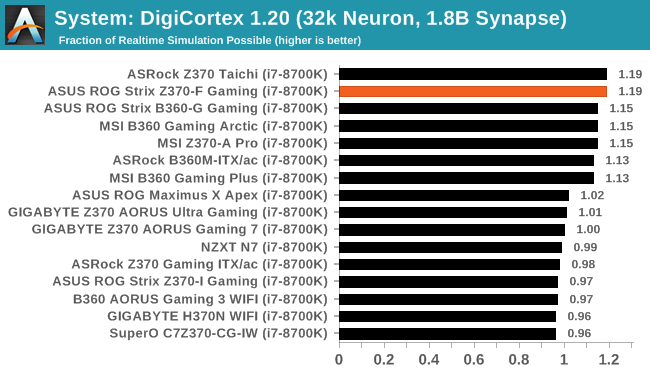
The DigiCortex results have the i7-8700K coming in matching our highest result reaching 1.19 fractions of real-time simulation possible. DigiCortex does show a decent spread between results which is different than we have seen previously. Again after sanity checks, we confirmed the clocks were the same and expecting this result to be a product of the new OS and testing adjustments.










4 Comments
View All Comments
sniperganso - Monday, October 1, 2018 - link
There is a mistake in the "Overclocking page", it says "ASRock Z370-F" instead of "ASUS Z370-F"CarlosR - Monday, October 1, 2018 - link
Has anybody tested the performance with more than 1 M.2 PCIe SSD while simultaneous access of data? I am not sure how the line sharing is affecting the performance.dakishimesan - Monday, October 1, 2018 - link
This is the motherboard I have in my system. Each m.2 slot Can be used in x4 mode, but when you do so with both of them it disables sata ports five and six.prateekprakash - Monday, October 1, 2018 - link
Could you please confirm if the HDMI port is 2.0? Then it may support DRM to play uhd...